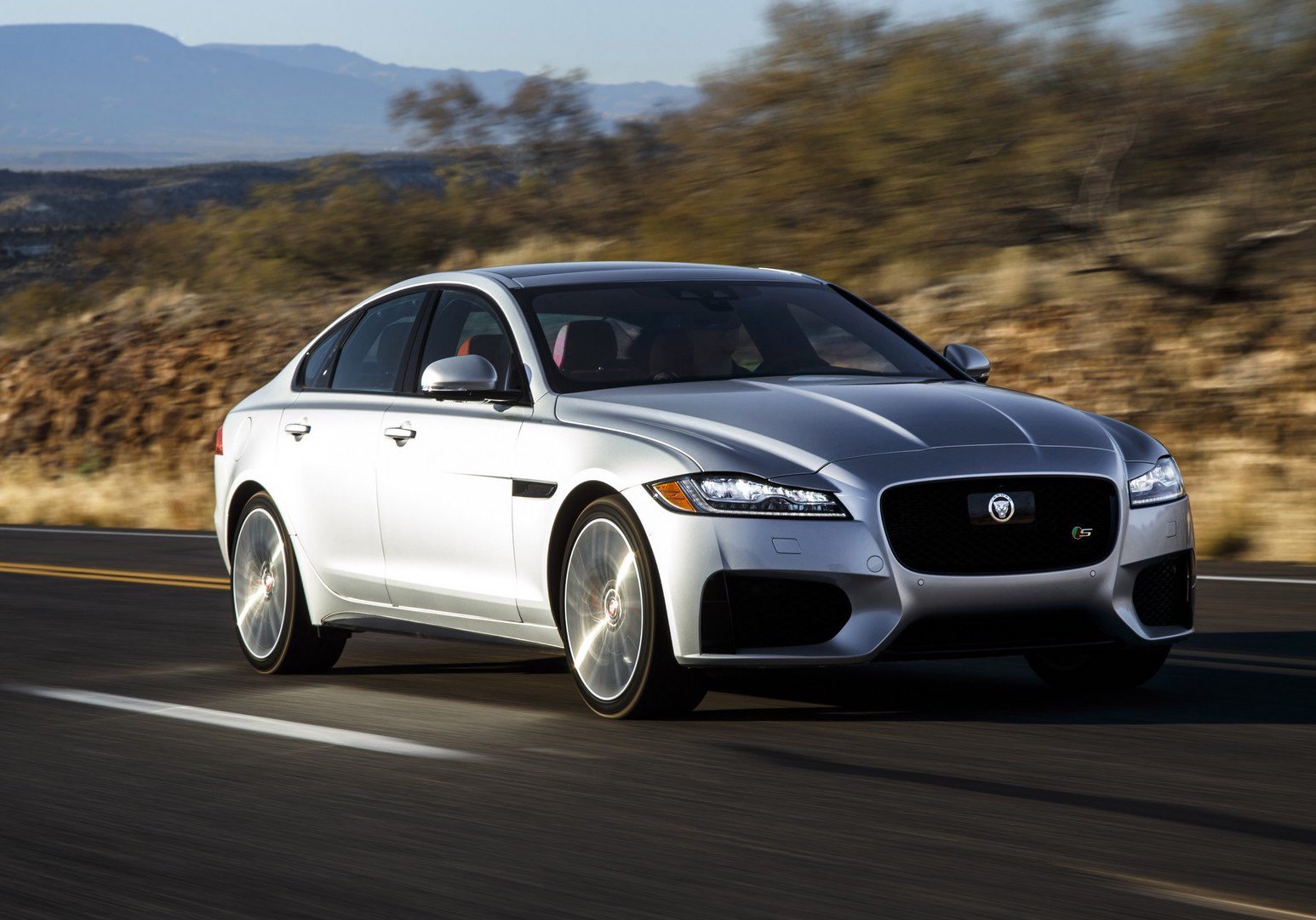“I believe the XF is the best-looking car in its class. Elegant, handsome and with proportions that imbue a great sense of integrity – the XF is true to the great tradition of sporting Jaguar saloons while being completely of its time.” – Ian Callum, Director of Design, Jaguar.
So, what is new about this luxury super sedan?
• Powertrain now available in 250PS Ingenium 2.0-litre four-cylinder petrol and eight- speed automatic transmission
• 10-inch Touchscreen infotainment system with Touch Pro technology provides seamless Apple CarPlay iOS smartphone connectivity
• Interior enhancements include illuminated treadplates and suedecloth headlining
• The Jaguar XF: lightweight construction, efficient powertrains and packed with technology
• Unrivalled refinement, dynamics and design
• Aluminium-intensive architecture optimises driving dynamics
• Elegant, progressive design combines short overhangs and outstanding proportions with
aerodynamic efficiency from Cd 0.26
• Powertrain now available in 250PS Ingenium 2.0-litre four-cylinder petrol and eight-speed
automatic transmission
• Double-wishbone and Integral Link rear suspension delivers exceptional ride comfort,
handling, and unrivalled refinement
• All-Surface Progress Control enables smooth, effortless drive-away on low-friction surfaces such as snow and ice – all the driver has to do is steer
• Audio systems include the exceptional 380W Meridian Surround Sound System
• Powered Gesture Boot Lid allows driver to open and close the boot lid even with hands full
The 2019 Jaguar XF Details
The Jaguar XF brings an unrivalled blend of design, luxury, technology and refinement to lead the business car segment, underpinned by class-leading driving dynamics and refinement.
The dynamic, coupé-like design is formed around Jaguar’s aluminium-intensive architecture and combines the outstanding proportions, elegant surfaces and perfect lines which define all Jaguar cars. The cabin is a seamless blend of contemporary luxury materials and finishes, traditional Jaguar craftsmanship and intuitive technology.
The XF uses Jaguar’s aluminium-intensive architecture to provide a unique combination of lightweight construction and optimised driving dynamics. Double wishbone front suspension and Integral Link rear suspension – combined with near 50:50 weight distribution – deliver the ideal balance between ride and handling.
In rear-wheel drive form, the All-Surface Progress Control (ASPC), developed for low-speed driving in adverse conditions, automatically manages the brakes and the throttle to deliver the best possible traction, enabling the car to pull away smoothly and without drama: the driver only has to steer. ASPC is fitted to all automatic models and operates between 3.6km/h and 30km/h, and the desired speed is set by the driver using the cruise control switches.
The Touch Pro system, when enhanced with Connect Pro, customers benefit from InControl Apps, Remote, Navigation Pro and 4G Wi-Fi hotspot through the vehicle’s advanced and intuitive 10-inch T ouchscreen.
Audio systems include the exceptional 380W Meridian Surround Sound System.
Touch Pro features a high-performance quad-core processor and runs on state-of-the-art, ultra-fast Ethernet, a network technology that offers exceptional data transfer rates. Combined, they deliver faster response times.
As part of this update, a new Smartphone Pack which features Apple CarPlay for enhanced smartphone compatibility is standard on all models. The technology mirrors the user’s smartphone allowing them to access a selection of apps on the car’s 10-inch Touchscreen.
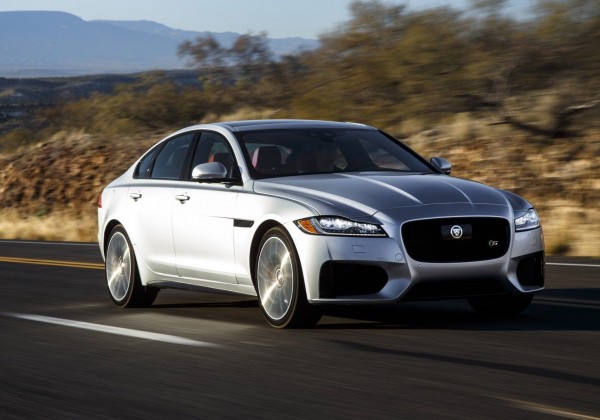
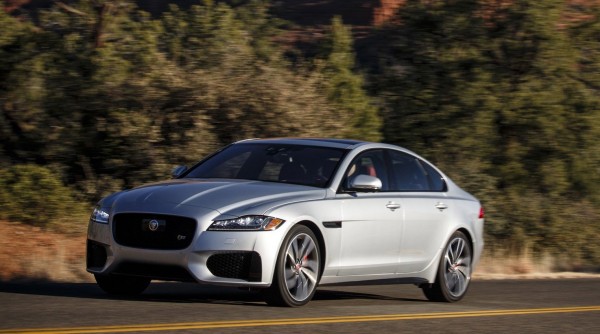
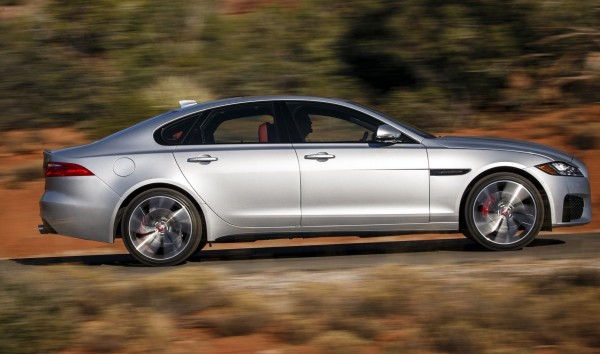
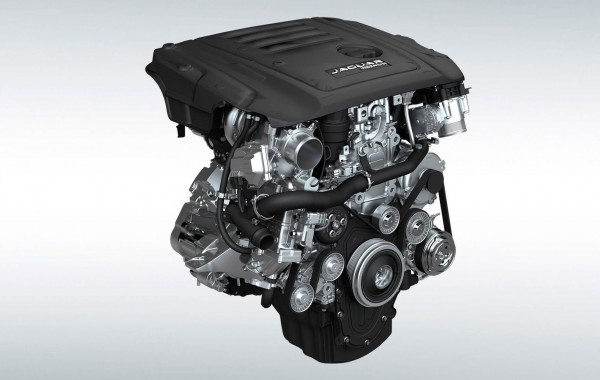
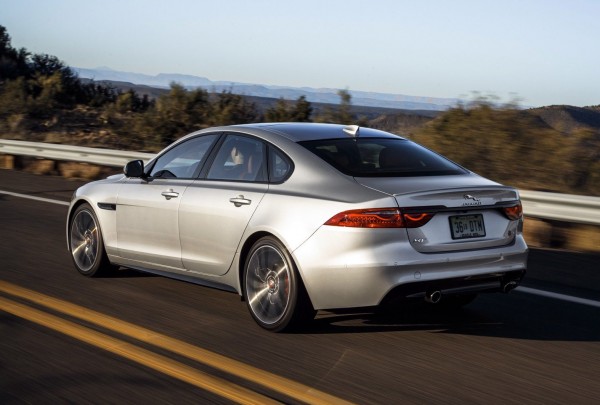
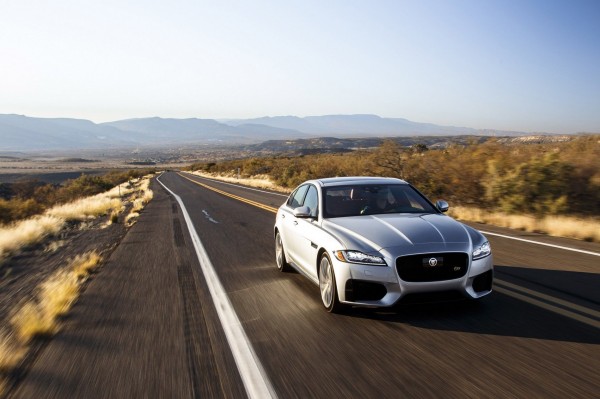
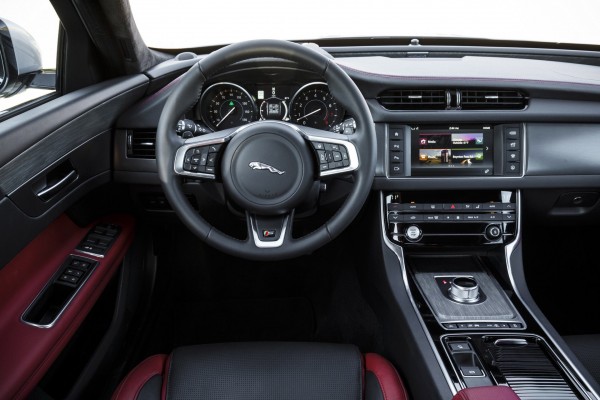
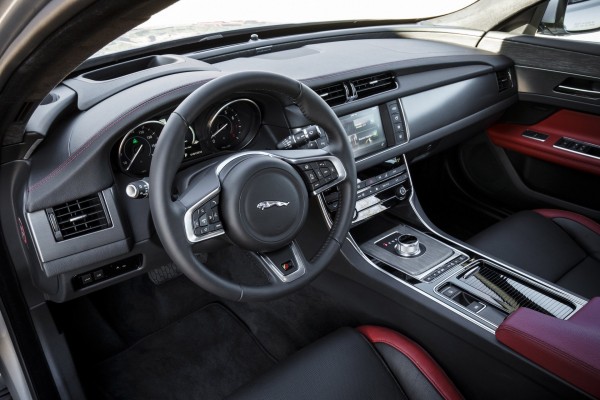
RANGE SUMMARY
The XF will be available in Prestige and R-Sport in 250PS Ingenium 2.0-litre four-cylinder turbocharged petrol automatic RWD.
DESIGN
Staying true to the principles of elegant lines and disciplined surfacing, the Jaguar XF is one of the most visually dynamic cars in the executive segment.
Integrity, simplicity: Perfect proportions, aerodynamic efficiency
“In creating the XF, as a design team we were driven by discipline, the discipline of simplicity. Every exterior line on the XF has a clear purpose – nothing is superfluous. Achieving that simplicity takes time and requires great determination; it’s all too easy to add lines to a car, but much harder to add character by leaving lines out.
Inside too, we have been driven by the desire to ensure the XF’s cabin is as comforting as it is comfortable. Innovative technology, including the 10-inch Touchscreen, is combined carefully with materials that cosset and reassure.” – Ian Callum, Director of Design, Jaguar
From any angle the XF is instantly recognisable as a Jaguar. The sleek, coupé-like profile, long bonnet with deep power bulge and the short front overhang mark this car out as a sporting saloon that stands apart from the crowd.
Aerodynamic performance is optimised by apertures in the front bumper, which channel air over the front wheels. This helps to prevent the turbulent wheel wake from disturbing the smooth laminar airflow passing around the car.
The headlights are flush with the surrounding panels, improving not only aesthetics but also aerodynamics. They also feature Jaguar’s signature DRL.
The power bulge on the long aluminium bonnet runs all the way through to the nose cone, emphasising the car’s performance potential, integrating Jaguar’s latest-generation deployable bonnet technology to the rear hinge assembly. Not only does this contribute to the sleek styling but also optimises visibility and pedestrian protection.
The one-piece aluminium bodyside pressings emphasise Jaguar’s philosophy that surfacing should always be executed with the discipline of simplicity and purity. Designing and manufacturing these panels from a single sheet is extremely challenging but contributes not only to the overall stiffness of the body, but also to surfacing purity and quality because there are no visible joints.
The elegant daylight opening graphic features a full return, the form inspired by past Jaguar sports saloons. With radii honed to within fractions of a millimetre to deliver the complex curvature, the feature is testament to Jaguar’s expertise in working with aluminium.
Running from front to back, peaking above the rear wheel in terms of height and then tapering away, is a chamfered feature line known as ‘the spear of light.’ The reflections make the car appear even more lithe, more agile, and more elegant.
At the rear, the LED tail lights feature the signature Jaguar graphic from F-TYPE – a line intersecting a roundel – also used on the XE. But here, the graphic is repeated, creating a clear hierarchy from XE, and an unmistakable pattern at night: everybody knows that this is the XF.
The chrome signature blade running across the boot lid between the light clusters emphasises the XF’s taut surfaces and dynamic visual balance.
To deliver the flush fit of the light clusters and perfect integration of the chrome blade, the boot lid is made from two steel pressings joined by laser brazing. As well as being highly energy-efficient, this state-of-the-art process was selected for its precision and neat, clean finish.
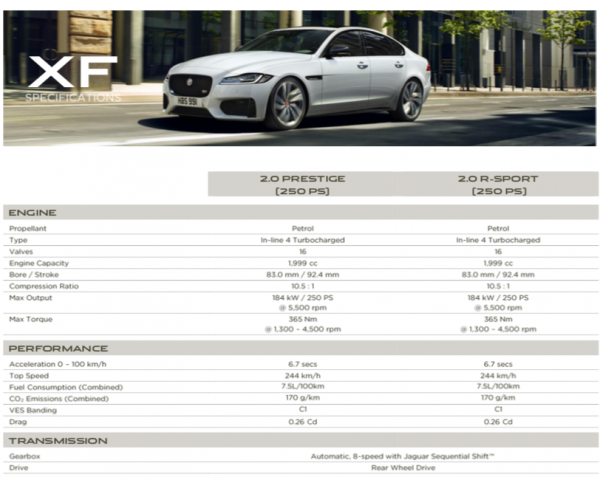
Interior design: simplicity, strength, space
The interior of the XF has always attracted praise, especially the start-up sequence bringing the car to life as the rotary gear selector rises up from the centre console and the air vents rotate into position.
The brief was to retain that sense of occasion – and the strong, simple lines and horizontal feel of the instrument panel – but mature the design language and the use of materials, befitting the XF’s status now that XE is in position as the entry-level Jaguar sports saloon.
The layered instrument panel, with Jaguar signature ‘Riva Hoop’ inspired by XJ, continues into the door, creating a unique cabin feel. This is enhanced by the generous application of veneers such as Gloss Figured Ebony and textured aluminium trim such as Dark Hex.
Appreciation of the XF’s interior starts from outside – there’s an approach sequence leading you into the car as the Jaguar Intaglio at the centre of the Riva Hoop is lit up.
Once in your seat, you notice how the doors shut with reassuring precision and a sound painstakingly engineered to match the premium materials and perfect execution of the interior. Press the engine start button and watch the backlighting fade: the effect is calming – this is your personal space.
Look around and you notice the height of the waistline and the centre console: this enhances the feeling of being sat in the seat rather than on it, creating a sense of safety, comfort and security. The strong horizontal theme of the instrument panel, the layering of it, and the materials used for each layer creates a rich, luxurious, handcrafted feel.
Enhanced front seats provide even more comfort for driver and front passenger as the upgraded ‘Luxury’ seats now provide powered ‘Z’ headrests with manually adjustable wings.
The XF’s 2,960mm wheelbase means that rear passengers enjoy traditional Jaguar comfort while options such as the four-zone climate control system, heated seats and window blinds make the second row an even more comfortable place to be.

ARCHITECTURE AND BODY STRUCTURE
The XF features a light, stiff body structure made predominantly from aluminium
Material benefit: aluminium-intensive construction
Aluminium alloys, self-piercing rivets, and structural adhesives: these are the essential elements around which every Jaguar is designed. Used to create inherently light, stiff body structures, they enable the highest standards of performance, efficiency, safety and dynamics.
These attributes were engineered into Jaguar’s aluminium-intensive architecture from the very beginning. It is from this state-of-the-art modular structure that the XF was developed. Also featuring advanced high-strength steels, the aluminium-intensive monocoque uses materials intelligently, exploiting each to its full potential.
Aluminium is also used to make the bonnet and front fenders, while the front-end carrier and cross- car beam are cast from even lighter magnesium alloys.
The aluminium-intensive monocoque leverages more than a decade’s experience of manufacturing luxury cars from aluminium in high volume. The one-piece bodysides of the XF are testament to Jaguar’s world-leading expertise in working with the material.
Stamped from a single sheet of high-strength 6000-series alloy, the bodysides weigh less than 6kg and are among the most technically-challenging panels Jaguar has developed and push the very limits of what is possible in terms of designing and manufacturing in aluminium. Perfecting the deep haunches and the sixth-light incorporated all of the learnings from F-TYPE in terms of depth of draw and tightness of radii.
Assembly to the rest of the structure uses a two-stage framing process. The technique allows for greater joint efficiency through optimised positioning of the rivets. This translates to increased torsional rigidity of the body.
Features such as the high-pressure die-cast aluminium front suspension towers increase local stiffness and make a significant contribution to the XF’s benchmark ride, handling and steering.
Quieter by design
The body of the XF is designed to behave as one homogeneous structure: wherever vibration energy finds a discontinuity it will concentrate and then radiate noise through to the cabin. As a result, reducing structure-borne noise is an important way of delivering customary Jaguar refinement.
Every part of the body has been analysed to ensure as many potential sources of noise have been designed-out. In some areas, such as the crash structure behind the front bulkhead, fully-sealed, double-wall structures are used. Where sound deadening has been applied, the latest spray-on materials are used due to their combination of higher performance and lower weight.
Foam baffles inside the aluminium sections also contribute. These pieces are fitted during assembly: as the body passes through the e-coating ovens the heat causes the foam to expand so that it completely fills the section.
A further example of the painstaking attention to detail that delivers XF’s benchmark low levels of cabin noise is typified by the way in which the high-level brake light is fitted to the body. Running all the way along the full length of the rear screen, this full-LED light has a seal and an acoustic barrier behind to minimise any noise leakage through to the interior.
Closing the loop: Recycled aluminium alloy
Aluminium pressings used where stiffness is a key criterion, such as under frame reinforcements, are typically formed from 5000-series alloys. These include RC5754, a grade unique to Jaguar, which is made predominantly from recycled material and also used on the XE sports saloon.
Around half of this is scrap sourced from the press shops, helping not only the move towards closed- loop recycling but also reductions in overall electricity consumption and therefore lifecycle CO2 emissions. Innovations like this are a further example of Jaguar’s world-class aluminium expertise and drive for environmental sustainability.
Structural integrity: World-class safety
The XF has been engineered to meet the most demanding crash test requirements in the world, achieving the maximum five-star Euro NCAP rating. As part of the intelligent material mix in the body, the rear longitudinal members and the B-pillar reinforcements are made from ultra-high strength hot- formed boron steels, providing exceptional rigidity and stability of the occupant safety cell.
Pedestrian protection is provided by the energy-absorbing properties of the front bumper and enhanced by Jaguar’s latest-generation deployable bonnet technology.
The system uses pressure sensors mounted in the front bumper to detect collisions with pedestrians. When deployment is initiated, pyrotechnic piston actuators integrated into the rear bonnet hinges fire, and, in 40 milliseconds, can lift the trailing edge of the bonnet by approximately 130mm. This increases clearance between the pedestrian’s head and hard points in the engine compartment, helping to mitigate head injuries.
Jaguar’s commitment to improving pedestrian protection in this way began back in 2006 with the launch of the XK.
CHASSIS
The Jaguar XF exceeds all expectations of how a business saloon should ride, handle and steer.
Dynamic, agile, composed
Whether on a mountain road or a motorway cruise, from behind the wheel or relaxing in the back, the XF is designed to deliver a driving experience that sets the class standard.
The light yet exceptionally stiff body, with its combination of aluminium and advanced high-strength steels, delivers near 50:50 weight distribution – the ideal starting point for dynamics development.
Double-wishbone front and Integral Link rear suspension systems provide the inherently high levels of stiffness needed for agile handling and steering precision with the compliance essential for first- class comfort and refinement. Advanced damper technologies – both passive and continuously variable – improve ride quality still further and extend the XF’s breadth of dynamic capability.
“The XF has to deliver driver reward through agility and immediacy of response when it’s called for, and yet great ride composure and comfort too. The XF’s light and rigid aluminium intensive architecture is a key enabler for us delivering those attributes, as it provides an optimal basis for finely tuning the ride and handling characteristics of the car. The result is that the XF is as satisfying to drive quickly, as it is comfortable to be driven in.” – Mike Cross, Chief Engineer of Vehicle Integrity, Jaguar
With components made entirely from lightweight aluminium, the XF’s double-wishbone front suspension is modelled closely on F-TYPE’s and was chosen because, fundamentally, there is no better configuration.
Its exceptionally high camber stiffness means the tyres are able to generate lateral force immediately – which translates to sharper and more immediate turn-in. And the high roll camber gain means that the tyre’s contact patch is maintained, generating more grip and delivering better feel.
Other refinements include lighter springs made from narrower-gauge steel and low-friction, PTFE- lined bushes for the tubular anti-roll bar.
Integral Link: Forces separated
The optimum balance of ride and handling requires lateral and longitudinal stiffness to be tuned independently. This simply isn’t possible with a conventional multi-link suspension rear suspension: changes to one will affect the other, leading to compromises in the vehicle’s dynamics attributes.
Integral Link is different, enabling the XF to realise exceptional levels of comfort and handling. Bushes soft in recession allow the wheels to move rearwards and upwards upon impact, providing excellent energy absorption characteristics.
At the same time, camber stiffness can be increased, delivering greater responsiveness. Greater caster stiffness can also be achieved, for greater stability under braking.
Electric power-assisted steering
Steering response and on-centre feel are among the most important attributes to define Jaguar’s dynamics DNA and this is evident with the XF.
Everything from the tyres through to the steering wheel itself makes a difference but one of the key enablers is the enormous tuning potential of electric power-assisted steering (EPAS). From filters that damp unwanted disturbances caused by road surface irregularities to algorithms that compensate for changes in ambient temperature – EPAS has far more to offer than hydraulic systems ever could.
Incorporating all of the learnings from F-TYPE and XE, the advantages of EPAS give the XF an even more connected feel with intuitive, linear responses.
Torque Vectoring by Braking
Another technology proven first on F-TYPE and standard on the XF is Torque Vectoring by Braking. On corner entry, lightly braking the inner wheels individually can mitigate understeer and help the driver to take the ideal line. Intervention is subtle and virtually transparent to the driver, but the increased agility is felt immediately.
Next-generation damper technology: smooth progress
Making the XF’s body lighter and stiffer delivers inherent benefits in terms of ride control, but Jaguar’s dynamics engineers looked closely at other fundamental improvements that could be made when developing the XF. One of the most effective is the integration of next-generation passive damper technology to enhance comfort.
Passive dampers enable frequency-dependent damping – the ability to vary damping force not only with the velocity at which the damper piston moves, but also as a function of its frequency. Inputs from road surface imperfections are high frequency inputs and large road undulations are low frequency.
An extra valve in the piston provides an additional bypass. Over road surface imperfections this extra valve opens, allowing some fluid to flow through it instead of the main valve in the piston. This reduces the damping force and makes the ride smoother and the driving experience even more relaxing. On smooth road surfaces the valve is closed, forcing all of the fluid to pass through the piston: damping force increases and the ride becomes more controlled.
POWERTRAIN. Responsive, refined, rewarding
The XF’s four-cylinder Ingenium petrol engines are engineered for exceptional response, smoothness and refinement, and all benefit from stop-start systems and smart regenerative charging. Characterised by a rapid build-up of torque from low speeds to give effortless acceleration, the linear throttle response and refined soundtrack makes the driving experience as intuitive as it is rewarding. The XF offers a truly remarkable breadth of performance and capability.
Designed, developed and manufactured in-house to meet Jaguar’s exacting requirements for power, torque and refinement, Ingenium is a modular family, which will deliver a wide range of world-class diesel and petrol engines.
The XF is available 2.0-litre four-cylinder petrol rated at 250PS/380Nm. Every measure has been taken to ensure these engines are as clean as they are quiet and smooth-running.
Features such as the offset cylinder bores and roller bearings for the camshafts and balancer shafts contribute to Ingenium’s benchmark low levels of internal friction.
The split-cooling system features a mapped thermostat, a variable-flow pump and crossflow channels in the cylinder head to ensure a rapid warm-up from cold. A variable flow oil pump and switchable piston cooling jets cut parasitic losses still further and therefore reduce fuel consumption and emissions.
Ingenium is also one of the first diesel engines to feature variable valve timing. A cam phaser on the exhaust side allows the catalysts to reach operating temperature even more quickly, further reducing emissions. The technology also enables more efficient and robust regeneration of the particulate filter.
Complementing the inherently low levels of vibration ensured by the design of the stiff, deep-skirt cylinder block are acoustic covers fitted to the cylinder head, the chain drive and the sump. These covers prevent radiated noise from the engine from reaching the cabin and contribute to the XF’s exceptional levels of refinement. Switchable engine mounts provide extremely effective isolation from the body, further reducing the transmission of structure-borne noise.
All petrol engines are now equipped with particulate filters to make them even cleaner.** The highly efficient, close-coupled filters are neatly integrated into the aftertreatment system and trap ultrafine particles as the exhaust gas passes through them. Under normal driving conditions, the trapped particles will be oxidised into CO2 and the filter regenerated whenever the driver lifts off the accelerator.
Four-cylinder petrol power: Responsive and refined
The 2.0-litre four-cylinder Ingenium petrol engines have been developed entirely in-house.
All Ingenium engines deliver benchmark low levels of friction to optimise efficiency and refinement while the new petrol units deploy twin scroll turbos to reduce lag and optimise power output.
Continuously Variable Valve Lift technology improves air delivery to the engine.
The powerplant features electrohydraulic valve control to deliver unrivalled flexibility. This patented technology provides fully variable control of the intake valve lift for optimum efficiency, power and torque across the rev range.
In addition, cleaner combustion is ensured by a new 200bar direct injection system, which features centrally mounted injectors with optimised spray patterns to improve efficiency and reduce emissions.
In a first for Jaguar, the exhaust manifold is also integrated with the cylinder head casting. Passing coolant through the manifold considerably reduces warm-up times, when engines are at their least efficient, to enhance fuel consumption and control emissions.
Comfortably ahead: smooth 8-speed automatic transmissions
Every engine in the XF is available with a specifically optimised version of ZF’s peerless eight-speed automatic. Combined with Jaguar’s unique rotary gearshift controller and paddle shifts, these state- of-the-art transmissions offer an unparalleled driving experience, blending exceptionally smooth launch behaviour with seamless shifting and efficiency.
The transmission controller monitors driving styles and adapts its shift patterns to suit. The ECU is also networked to the Jaguar Drive Control, offering even quicker shifts and more dynamic kickdown in Dynamic mode, and earlier up-shifts in Eco mode.
Complementing the stop-start system is Transmission Idle Control: if the vehicle is stationary and held against the brakes with the engine running, one of the brakes inside the transmission opens, reducing drag losses and therefore further reducing fuel consumption.
To improve driving comfort even further when running at very low engine speeds, all applications feature a pendulum damper in the torque converter. This additional element is able to absorb very low frequency vibrations and prevent them from passing through to the cabin.
INCONTROL INFOTAINMENT AND CONNECTIVITY
Touch Pro: World-class infotainment technology
At the heart of Touch Pro is a 10-inch capacitive Touchscreen. Like a smartphone, the home screen can be customised: widgets can be added to provide shortcuts to favourite features. It’s even possible to add extra home screens. And the Touchscreen accepts the ‘pinch to zoom’ gestures familiar to all smartphone users – nothing could be more intuitive to use.
The optional enhanced 10-inch Touch Pro Dual View enables the central screen to display vehicle information, such as satellite navigation for the driver while the front seat passenger is able to access radio, USB or TV outputs simultaneously using the same screen.
XF Navigation Pro benefits from dead-reckoning functionality, which interprets vehicle data up to 40 times a second, and can accurately, position the vehicle even when GPS signals can no longer be received – perfect for city centres.
When combined with Connect Pro, Navigation Pro utilises a data connection to enable greater functionality and location-based features and information. This includes the Live Traffic function which alerts the driver to traffic jams on their route in order to make their journey more seamless. The XF also offers door-to-door route planning and guidance incorporating public transport options, Commute Mode which learns your daily drive so that it can automatically offer alternative routes to avoid congestion using historical and real-time traffic information, and Arrival Mode which shows a 360° interactive view of your destination when you’re 200m away – it will even advise on the nearest available car parking spaces.
If you just want to enjoy the music, functions such as ‘Play more like this’ make it even simpler to access all of your favourite tracks. To make the most of it all there’s the option of a 17-speaker, 825W Surround Sound System developed with renowned British audio experts Meridian. The system benefits from Meridian’s Trifield and Audyssey’s MultEQ XT technologies to ensure optimum sound reproduction with benchmark low levels of distortion.
The modules that make up Touch Pro are connected using Ethernet, and Jaguar is one of the very first vehicle manufacturers to integrate this network technology into its electronic architectures. With a bandwidth of up to 1Gbit/ second, Ethernet can cope with high volumes of data, enabling very high infotainment system performance.
Together with a powerful quad-core processor and Ethernet allows Touch Pro to deliver smooth graphics and fast response times. These technologies also ensure that the system’s capability can be enhanced even further in the future.
Always on: The connected XF
Dialling-in to a conference call, booking a hotel room or just catching up with the news – with InControl Apps the XF ensures drivers can seamlessly connect Apple and Android smartphones to the car. Via a USB cable and the dedicated port in the centre console, InControl Apps provides access to the compatible apps on the device using the vehicle’s Touchscreen.
Remote Essentials functionality, standard on all models, is accessed through the Remote app and enables customers to interact with the XF from anywhere using a smartphone. It can display how much fuel is in the tank, whether the doors are locked and if the windows were left open.
For the last word in comfort and convenience, on most models equipped with automatic transmissions, Remote Premium enables the driver to bring the cabin to a pre-set temperature by remotely starting the engine. A press of a smartphone button is all it takes for the XF’s highly effective climate control system to heat or cool the interior to the desired temperature before the journey even begins – perfect for hot summer days or freezing winter mornings.
Using a SIM card and the vehicle antenna for the strongest and most reliable signal, the XF goes online and can function as a Wi-Fi hotspot, providing a 4G connection for up to eight devices.
Online Media allows for the aggregation of numerous content providers and their personalised content – such as Deezer and Spotify – that gives access to more than 40 million music tracks and four million on-demand programmes and podcasts. For the first time, these can be directly streamed from the vehicle without the need for a smartphone – providing a seamless and integrated experience.
Should car be involved in a collision severe enough to trigger the airbags, Protect will automatically notify the emergency services and provide the GPS location of the vehicle. Occupants can also trigger an emergency call manually by pressing a button.
All-round convenience: Hands-free Gesture Boot Lid
Powered Gesture Boot Lid delivers greater driver convenience with a hands-free solution to access the bootspace even when the owner has their hands full. The system is available with keyless entry and parking aid and allows the owner to open and close the tailgate by simply waving their foot underneath the rear bumper of the vehicle.
Sensors beneath the rear valance are able to detect any movement as the customer swipes their foot underneath. This triggers the boot lid opening, making it possible to load any items into the loadspace without having to put them down.
DRIVER ASSISTANCE
From traction systems which know the type of surface you’re driving on to a stereo camera which read the road ahead: the XF features all of the intelligent technologies needed to reduce driver workload and make even the longest journeys feel effortless and stress-free.
Getting to grips: All-Surface Progress Control
Even the most expert drivers can struggle to pull away smoothly on very low-friction surfaces such as snow, ice or wet grass – especially in a rear-wheel drive car. From a hill start it can be near- impossible because even the slightest pressure on the accelerator can be enough to break traction.
Conventional traction control systems attempt to modulate what happens after the wheels begin to slip – and often that’s too late. Which is why the XF features Jaguar’s revolutionary All-Surface Progress Control (ASPC) system.
Leveraging the knowledge built up over decades of Jaguar Land Rover experience in off-road technologies, ASPC delivers a step-change in capability because there’s no driver input on the pedals: the driver just has to steer.
ASPC works like a low-speed cruise control and can operate between 3.6km/h (2.2mph) and 30km/h (19mph). The system is activated by pressing a button on the centre console after which, the driver uses the cruise control switches on the steering wheel to set the maximum speed. The system then does all the hard work.
What makes ASPC so effective is that it doesn’t just provide fine control of the throttle: it also uses the brakes in opposition to the throttle so that, from standstill, only very low engine torque is applied to the driven wheels. This unparalleled capability ensures smooth progress with little or no wheel spin.

